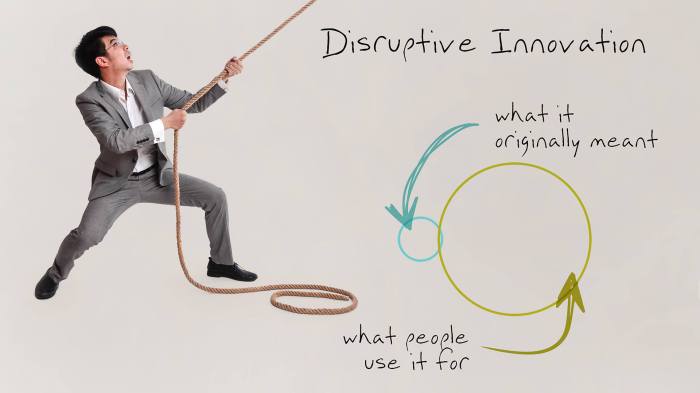
Disruptive innovation strategies are reshaping the business landscape, challenging established norms and creating new markets. Understanding these strategies is essential for companies aiming to thrive in an ever-evolving environment. By examining successful examples and the unique characteristics that set disruptive innovations apart from sustaining innovations, businesses can harness the power of disruption to foster growth and adaptation.
In the rapidly changing world of business, companies need to embrace innovative thinking and strategies to stay competitive. Disruptive innovation not only alters the way products and services are delivered but also influences organizational culture, international expansion, and customer engagement, making it a critical area of focus for any forward-thinking entity.
Understanding Disruptive Innovation Strategies

Disruptive innovation refers to a process whereby a smaller company with limited resources successfully challenges established businesses. It plays a significant role in reshaping markets and creating new value propositions that appeal to consumers, often by meeting needs that existing products fail to address. This section delves into the essence of disruptive innovation, highlighting its importance in today’s dynamic business landscape.
Defining Disruptive Innovation
Disruptive innovation is characterized by its ability to create new markets and value networks, ultimately displacing established market-leading firms, products, and alliances. A classic example is Netflix, which revolutionized the way people consume media by transitioning from DVD rentals to streaming services, effectively impacting traditional cable television and movie rental services.
Characteristics of Disruptive Innovations
Disruptive innovations differ fundamentally from sustaining innovations that merely enhance existing products. Key characteristics include:
- Market Creation: Disruptive innovations create new markets where none existed before.
- Affordability: These innovations often provide simpler, more affordable solutions compared to existing offerings.
- Accessibility: Disruptive innovations are typically designed to be accessible to a broader audience, which helps in capturing non-consumers.
Successful Examples Across Industries
Several industries have witnessed transformational shifts due to disruptive innovations.
- Travel Industry: Airbnb disrupted the hotel industry by allowing homeowners to rent out their spaces, creating an entirely new lodging market.
- Retail Sector: Amazon’s foray into e-commerce transformed traditional retail businesses, emphasizing convenience and fast delivery.
- Transportation: Companies like Uber have disrupted the taxi industry by leveraging technology to offer ride-sharing services.
Business Innovation Techniques
Fostering an innovative culture within an organization is essential for adapting to changing market dynamics. Business innovation techniques can encourage creativity, streamline processes, and enhance overall performance.
Techniques for Fostering Innovation
Organizations can employ various techniques to promote innovation:
- Brainstorming Sessions: Regularly scheduled sessions can encourage idea generation and collaborative thinking.
- Innovation Labs: Creating dedicated spaces for experimentation allows teams to innovate without the constraints of regular business operations.
- Feedback Mechanisms: Establishing channels for feedback from employees at all levels can lead to new insights and improvements.
Leadership’s Role in Innovation
Leadership plays a crucial role in fostering a culture of innovation. Leaders must inspire and empower their teams by:
- Encouraging Risk-Taking: Leaders should create an environment where employees feel safe to take calculated risks.
- Providing Resources: Allocating time and budget for innovative initiatives is essential to their success.
- Recognizing Contributions: Celebrating innovative efforts boosts morale and motivates teams to continue thinking creatively.
Case Studies of Successful Business Innovations
Several companies have successfully implemented innovative strategies that led to significant growth and market leadership:
- Apple: By focusing on design and user experience, Apple transformed personal electronics with the iPhone.
- Google: Its commitment to innovation through projects like self-driving cars and Google X has kept it at the forefront of technology.
- Procter & Gamble: Leveraging open innovation, P&G has collaborated with external partners to enhance its product development process.
Strategies for International Business
Disruptive innovation also has profound implications for international business expansion. Companies must adapt their strategies to leverage disruptive principles effectively in global markets.
Impact of Disruptive Innovation on International Expansion
Disruptive innovations can accelerate international business by allowing companies to enter new markets with lower-cost solutions that appease local consumer needs. A prime example is how mobile payment systems, such as M-Pesa in Kenya, have emerged due to a lack of traditional banking infrastructure, transforming how financial transactions are conducted globally.
Traditional vs. Disruptive Business Models

Traditional business models often rely on established practices and customer segments, while disruptive models emphasize agility and customer-centric approaches:
- Customer Segmentation: Traditional models target existing customer segments, whereas disruptive models often serve overlooked or new customer segments.
- Revenue Streams: Traditional businesses typically rely on one or two revenue sources, while disruptive businesses explore multiple channels.
- Speed to Market: Disruptive innovations prioritize rapid development and deployment to seize market opportunities quickly.
Strategies for Entering New Markets
When entering new markets, companies can utilize disruptive innovation principles:
- Localized Solutions: Tailoring products to meet specific local needs enhances acceptance.
- Partnering with Local Entities: Collaborations with local firms can leverage their market knowledge and established networks.
- Iterative Testing: Employing a test-and-learn approach allows businesses to refine their offerings based on real-time feedback.
Final Review
In conclusion, embracing disruptive innovation strategies is not merely about adapting to change; it’s about leading it. Companies that recognize the potential of these strategies are better equipped to navigate challenges and seize opportunities, ensuring their relevance and success in a competitive marketplace. As we move forward, the ability to innovate will continue to be a defining factor in the growth and sustainability of businesses worldwide.
Popular Questions
What is disruptive innovation?
Disruptive innovation refers to the process by which a smaller company with limited resources successfully challenges established businesses, often by introducing simpler, more affordable solutions.
How can companies implement disruptive innovation strategies?
Companies can implement these strategies by fostering a culture of innovation, investing in research and development, and being open to new business models that challenge the status quo.
What are some risks associated with disruptive innovation?
Risks include the possibility of investing in unsuccessful innovations, market backlash, and the challenge of existing companies reacting defensively to disruptive changes.
How does disruptive innovation affect job roles?
Disruptive innovation can lead to new job roles focused on innovation management, while also rendering some traditional roles obsolete as industries evolve.
Why is leadership important in promoting disruptive innovation?
Leadership is crucial as it sets the vision and supports a culture of risk-taking and experimentation, which are essential for fostering innovation within an organization.



